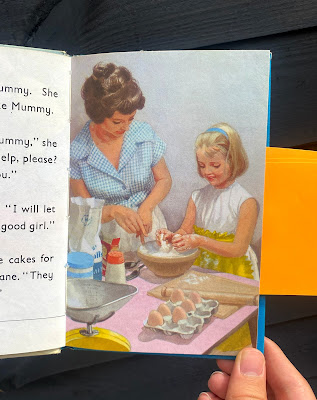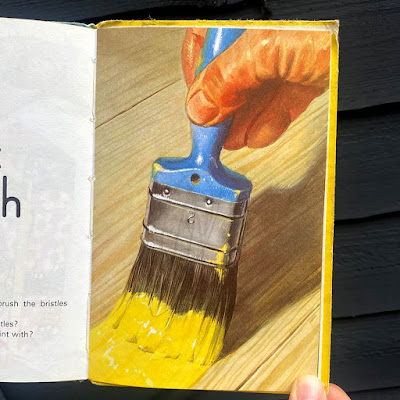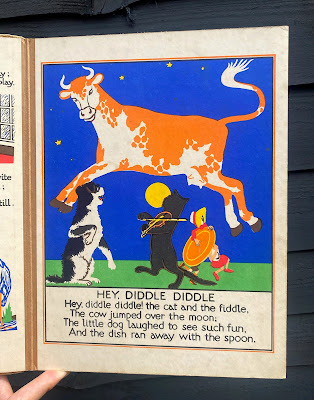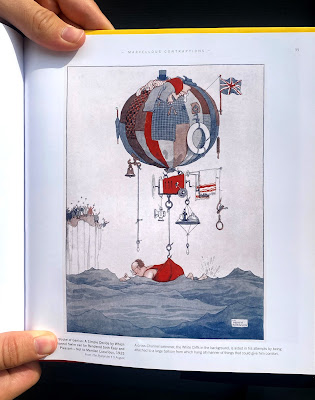INSPIRATIONS FROM THE BOOKSHELF An eclectic mix
Alison Padley-Woods invites Sara Netherway to tell us about the illustrators who have inspired her.
Picking a favourite children’s book from my collection would be like picking a favourite child, I’m seriously crazy about all of them! I’ve collected a lot of books. Many were my dad’s passed to me in four large freestanding book cases for which I am now family custodian. The books include many from several generations of his family dating from the 1800’s and some he had as a child.
 |
| Nursery Rhymes, illustrated by Alec Buckles, published by Thomas Nelson |
One nursery book from the 1930’s in particular I remember him reading to my children. It’s a very large heavy board book for a small child. Apart from the memory of the book, it’s wonderfully printed with bold colours and stylised characters. I couldn’t find much about the illustrator, Alec Buckles, apart from being described as an English painter, wood-engraver and book illustrator who also wrote and illustrated his own short stories for children. He was elected Associate to the Royal Society of Painters Etchers in 1924 and lived from 1892 to 1972.
Also on the shelves are children’s books from my childhood, including quite a few Ladybird books. I can’t remember reading them - I found reading hard as a child - but I remember looking at the pictures. Apart from their subject matter being of their time, I love the colour pallets and composition, with each page a little painted masterpiece. Many books in a series were made by several artists but they feel so cohesive.
 |
| A Ladybird Fifth Picture Book, by Ethel and Harry Wingfield, published by Ladybird |
 |
| Things We Do, by W Murray, illustrated by Harry Wingfield, published by Ladybird |
Harry Wingfield was one of the illustrators of the Peter and Jane series. Born in Denby, England, he initially wanted to work in engineering. Sadly, he failed to get an apprenticeship due to his stammer, but he took evening classes in drawing and met his wife there. Eventually he started his career with Ladybird in the 1950’s after serving in the Second World War. His wife, Ethel, using her knowledge as an expert in early learning, went on to collaborate with him on the Peter and Jane series and many other Ladybird books.
 |
| Things We Do, by W Murray, illustrated by Harry Wingfield, published by Ladybird |
There’s also an inspirational biography on the shelf. Best known for his illustrations of whimsical, elaborate machines that gave wild solutions to simple everyday problems, Heath Robinson was a name I was familiar with from childhood. To describe something as Heath Robinson meant it was over complicated and possibly a term used by my grandpa who had an engineer’s mind. But it wasn’t until I was was an adult that I started looking at William Heath Robinson's work. One of his inspirations was illustrator, Aubrey Beardsley, a contemporary of his, who incidentally would have gone into this article had it not been for children’s illustration.
Born in London, England, in 1872, William Heath Robinson’s father and two brothers had careers in illustration. William studied at the Royal Academy of Arts in London and initially wanted to be a landscape painter and, although he was talented, he looked to illustration to earn a living. His art was individual and accomplished and he successfully worked within different markets and with techniques from detailed watercolour to cartoons. During his varied career he also wrote and illustrated four picture books. It was his humorous work that successfully lifted spirits during the dark times of both World Wars. I love his whimsical witty machines best though, his characters, the stories within the drawings, and making them realistic enough to be believable.
 |
| Heath Robinson Masterpieces of Art, by Susan Grange published by Flame Tree Publishing |
I’ve also collected a small number of children's books by the American illustrator, Chris Van Allsburg’s. Having written and/or illustrated 21 books to date, his pencil work first drew me into his rich worlds. Author/illustrating with such a cinematic feel has enabled his books to be adapted into successful films such as Jumanji in 1981 and The Polar Express from 1985. Both books also won the Caldecott Medal and in 1980 he was awarded Caldecott Medal runner-up for The Garden of Abdul Gasazi. He was also nominated for the Hans Christian Andersen Award in 1986.
 |
| The Stranger, by Chris Van Allsburg, published by Clarion Books |
Chris Van Allsburg’s way of creating atmosphere inspires me. The Mysteries of Harris Burdick and The Stranger give me a feeling of unease, intrigue and drama much like an Edward Hopper painting. (An artist I also love for this reason).
 |
| The Mysteries of Harris Burdick, by Chris Van Allsburg, published by Andersen Press |
So Alec Buckles, Harry Wingfield, Heath Robinson and Chris Van Allsburg are my eclectic mix of inspirations for this article. And now I’m looking up at the books on my shelves, thinking of so many other illustrators who inspire me.
Header image, The Things We Do, published by Ladybird, illustrated by Alec Buckles
*















No comments:
We love comments and really appreciate the time it takes to leave one.
Interesting and pithy reactions to a post are brilliant but we also LOVE it when people just say they've read and enjoyed.
We've made it easy to comment by losing the 'are you human?' test, which means we get a lot of spam. Fortunately, Blogger recognises these, so most, if not all, anonymous comments are deleted without reading.